Matsue Castle
-Old style main tower looking at water city-
Overview
Name: Matsue Castle (Matsue-jo)
Alias: Chidori-jo
Place: Tonomachi Matsue, Shimane
Location: 35.47528247847825, 133.05123824412593
Type: Hill castle
Built: 1611
Remaining remnants: Main tower, stone walls and moats
Title: 100 famous Japanese castles, 12 original main towers, National Treasure, Designated national historical site
Matsue Castle (松江城) is located on the kamedayama hill in Matsue city, at the north of Ohasigawa River connecting Lake Nakaumi and Lake Shinjiko. Due to its location, Matsue city is a connecting point of water transportation toward inland Shimane prefecture through Lake Shinjiko and toward Tottori or outer sea through Lake Nakaumi, and known as a water city many canals crisscross.
Historically Yasuki area, the southern shore of Nakaumi was prosperous because of iron production made of iron sand collated around here. In Sengoku era, Amago clan which prospered in the former half of 16th century as the governor of eleven provinces in Sanin region used Gassan Toda castle (Shimane prefecture) located on hirose area going upstream several kilometers from Lake Nakaumi along with Inashi River as their main base.
Gassan Toda castle was surrounded by mountain and appropriate for defense, but distant from plain area it was not necessarily suitable for governance. After the fall of Amago clan, Mouri clan which ruined Amago clan also used Gassan Toda castle as their regional base at Sanin region.
After the battle of Sekigahara between Ieyasu Tokugawa (1543-1616) and Mitsunari Ishida (1560-1600) fought occurred at 1600, Mouri clan lost Izumo province including Gassan Toda castle, and insteadly Yoshiharu Horio (1542-1611), formerly the commander of Hamamatsu castle (Shizuoka prefecture), was appointed as a governor of Izumo province by Edo Shogunate, being evaluated his contribution to at the Battle.
Yoshiharu Horio was one of the oldest retainer of former ruler Hideyoshi Toyotomi (1537-1598). It is said that when Nobunaga Oda (1534-1582), master of Hideyoshi sieged Inabayama castle (currently Gifu castle) of Mino province (Gifu prefecture), Yoshiharu Horio guided Hideyoshi through a tricket toward backside gate of the castle, and contributed to sudden attack.
Yoshiharu had been engaged major battles of Hideyoshi and promoted, then Hideyoshi appointed him as a commander of Hamamatsu castle to hold Tokugawa army in case of accident. But considering the futurity of master (it was normal in this period), he supported Tokugawa side and let them pass through his territory.
Arriving at Izumo province at first Yoshiharu reformed Gassan Toda castle and used it as a temporal base, then in 1607 Yoshiharu started to build a new castle in Matsue. After four years, a huge castle with three main areas was completed in 1611. Matsue castle had one main tower, eight turrets and four gates, small number compared its size.
Matsue castle is built using oblong shaped hill of 400 meter long and 200 meter wide spreads north and south ward in the center of Matsue city. Originally castle place is a peninsular like height spreads in the muddy area, but Yoshiharu divided the body of the hill by moat and reclaimed the muddy area thus built an independent hill being surrounded by creeks.
The core area of Matsue castle is located at south half of the hill. Central area of the castle is a rectangular area of 150 meter and 80 meter wide, having a main tower at middle of eastern half. Originally this central area has two gates at its south line and northeast corner, six corner turrets and connecting corridor barracks, other than main tower. Its eastern line is protected by beautiful tall stone walls, but its western line has only low stone walls.
The main tower of Matsue castle is an externally five story and internally six story one, with a basement floor and entrance turret. Because of its boro-gata style consists of huge lower floors and small top floors, along with its black wall, this main tower gives the most massive impression among 12 original towers. Same as its exterior, its interior is also a uncouth one with minimum decoration (except for the castles of ruler, generally interior of main tower were quite simple became they were built as commanding place and storage).
Secondary area is a 100 meter long square shaped area at the south edge of the hill, with tall stone walls and three turrets. High stone walls curved along with the hill with connecting turrets has a powerful view from southward, Third area was built at the southern hillside, originally being separated by water moats and worked as a buffer area but now water moats were reclaimed. Huge stone step climbs from hillside toward secondary area has a powerful impression with a beautifully curved stone walls next to the step.
Contrary to the south half, north half of the hill is not so shaped and only protected by clay walls like medieval castles. Probably there might be a plan to build stone walls at whole part of the hill but cancelled because of budged limitation. But massive clay walls have sufficient defense ability even though lacking stone walls. In greater or lesser degree, many castle intensively decorates its front side with stone walls but its backside becomes corner-cutting. But its is more apparent in Matsue castle.
In 1633, Horio clan lost its territory because of no successor then Kyogoku clan which was the lord of Obama castle (Fukui prefecture) changed to the lord of Matsue castle. But Kyogoku clan also had no successor then changed to the lord of Tatsuno calste in 1637, then Matsudaira clan which was the descendant of Hideyasu Yuki (1574-1607), the second son of Ieyasu Tokugawa, became the lord of Matsue castle by the end of Edo era.
The origin of main tower (Tenshukaku) of Japanese castle is not clear, but it is said that progressed from a watchtower on the roof of main palace buildings. Old style main towers are clearly divided into the base building part with large gable roof, and small watch tower part with balcony surrounding whole part of the top floor. These style main towers are said as Boro-gata (watchtower style), and main towers of Inuyama castle, Maruoka castle, and Matsue castle are applicable to this style.
But along with the passage of time, these two parts became integrated into one tower, probable under the trend of increasing floors due to practical and authoritative reason, more stable structure is required. This style is said as Soto-gata (tower style), and in this style, the width of each floor gradually decreases upward and there is no sudden change like Boro-gata.
Among Soto-gata, early main towers were mixed style with Soto-gata, it means they had a large decorative roof extends each corner of the building, remains of former gable roof. But in later main towers, these decorative roof changed smaller and became merely a pattern of eaves. At last, a complete tower with only horizontally straight eaves were seemed as smart and built.
Main towers of Himeji Castle, Nagoya Castles or Ozu castle were applicable to former Soto-gata style, and Shimabara castle or Kameyama castle were later Soto-gata style.
Subsequent to Meiji revolution, all buildings except for main tower were sold and broken. Main tower was also once sold but bought back by local people and preserved. Now the site of the castle is used as a park, and three corner turret of secondary area, in front of the castle, were reconstructed in 2001. In May 2015, main tower of Matsue castle was newly nominated as a national treasure, along with other original main towers such as Himeji Castle, Matsumoto castle (Nagano prefecture), Inuyama castle (Aichi prefecture) or Hikone castle (Shiga prefecture) which had been already nominated.
20 minutes walk from JR West Sanin-Honsen line Matsue station. 20 minutes drive from Sanin Expressway Matsue-Tamatsukuri interchange.
Gassan Toda castle -Rapid rise and fall of Amago clan-
Hamamatsu Castle -Castle of promotion-
Himeji Castle -Castle of Kanbe and Hideyoshi-
Matsumoto Castle -Black main tower surrounded by mountains-
Inuyama Castle -Traditional style original main tower besides river-
Hikone Castle -Red colored army of Ii clan-
Type: Hill castle
Built: 1611
Remaining remnants: Main tower, stone walls and moats
Title: 100 famous Japanese castles, 12 original main towers, National Treasure, Designated national historical site
Brief History
Matsue Castle (松江城) is located on the kamedayama hill in Matsue city, at the north of Ohasigawa River connecting Lake Nakaumi and Lake Shinjiko. Due to its location, Matsue city is a connecting point of water transportation toward inland Shimane prefecture through Lake Shinjiko and toward Tottori or outer sea through Lake Nakaumi, and known as a water city many canals crisscross.
Izumo province before Matsue castle
Historically Yasuki area, the southern shore of Nakaumi was prosperous because of iron production made of iron sand collated around here. In Sengoku era, Amago clan which prospered in the former half of 16th century as the governor of eleven provinces in Sanin region used Gassan Toda castle (Shimane prefecture) located on hirose area going upstream several kilometers from Lake Nakaumi along with Inashi River as their main base.
Gassan Toda castle was surrounded by mountain and appropriate for defense, but distant from plain area it was not necessarily suitable for governance. After the fall of Amago clan, Mouri clan which ruined Amago clan also used Gassan Toda castle as their regional base at Sanin region.
After the battle of Sekigahara between Ieyasu Tokugawa (1543-1616) and Mitsunari Ishida (1560-1600) fought occurred at 1600, Mouri clan lost Izumo province including Gassan Toda castle, and insteadly Yoshiharu Horio (1542-1611), formerly the commander of Hamamatsu castle (Shizuoka prefecture), was appointed as a governor of Izumo province by Edo Shogunate, being evaluated his contribution to at the Battle.
Build of Matsue castle
Yoshiharu Horio was one of the oldest retainer of former ruler Hideyoshi Toyotomi (1537-1598). It is said that when Nobunaga Oda (1534-1582), master of Hideyoshi sieged Inabayama castle (currently Gifu castle) of Mino province (Gifu prefecture), Yoshiharu Horio guided Hideyoshi through a tricket toward backside gate of the castle, and contributed to sudden attack.
Yoshiharu had been engaged major battles of Hideyoshi and promoted, then Hideyoshi appointed him as a commander of Hamamatsu castle to hold Tokugawa army in case of accident. But considering the futurity of master (it was normal in this period), he supported Tokugawa side and let them pass through his territory.
Arriving at Izumo province at first Yoshiharu reformed Gassan Toda castle and used it as a temporal base, then in 1607 Yoshiharu started to build a new castle in Matsue. After four years, a huge castle with three main areas was completed in 1611. Matsue castle had one main tower, eight turrets and four gates, small number compared its size.
Structure of Matsue castle
Matsue castle is built using oblong shaped hill of 400 meter long and 200 meter wide spreads north and south ward in the center of Matsue city. Originally castle place is a peninsular like height spreads in the muddy area, but Yoshiharu divided the body of the hill by moat and reclaimed the muddy area thus built an independent hill being surrounded by creeks.
The core area of Matsue castle is located at south half of the hill. Central area of the castle is a rectangular area of 150 meter and 80 meter wide, having a main tower at middle of eastern half. Originally this central area has two gates at its south line and northeast corner, six corner turrets and connecting corridor barracks, other than main tower. Its eastern line is protected by beautiful tall stone walls, but its western line has only low stone walls.
The main tower of Matsue castle is an externally five story and internally six story one, with a basement floor and entrance turret. Because of its boro-gata style consists of huge lower floors and small top floors, along with its black wall, this main tower gives the most massive impression among 12 original towers. Same as its exterior, its interior is also a uncouth one with minimum decoration (except for the castles of ruler, generally interior of main tower were quite simple became they were built as commanding place and storage).
Outers area of Matsue castle
Secondary area is a 100 meter long square shaped area at the south edge of the hill, with tall stone walls and three turrets. High stone walls curved along with the hill with connecting turrets has a powerful view from southward, Third area was built at the southern hillside, originally being separated by water moats and worked as a buffer area but now water moats were reclaimed. Huge stone step climbs from hillside toward secondary area has a powerful impression with a beautifully curved stone walls next to the step.
Contrary to the south half, north half of the hill is not so shaped and only protected by clay walls like medieval castles. Probably there might be a plan to build stone walls at whole part of the hill but cancelled because of budged limitation. But massive clay walls have sufficient defense ability even though lacking stone walls. In greater or lesser degree, many castle intensively decorates its front side with stone walls but its backside becomes corner-cutting. But its is more apparent in Matsue castle.
In 1633, Horio clan lost its territory because of no successor then Kyogoku clan which was the lord of Obama castle (Fukui prefecture) changed to the lord of Matsue castle. But Kyogoku clan also had no successor then changed to the lord of Tatsuno calste in 1637, then Matsudaira clan which was the descendant of Hideyasu Yuki (1574-1607), the second son of Ieyasu Tokugawa, became the lord of Matsue castle by the end of Edo era.
Style of main tower
The origin of main tower (Tenshukaku) of Japanese castle is not clear, but it is said that progressed from a watchtower on the roof of main palace buildings. Old style main towers are clearly divided into the base building part with large gable roof, and small watch tower part with balcony surrounding whole part of the top floor. These style main towers are said as Boro-gata (watchtower style), and main towers of Inuyama castle, Maruoka castle, and Matsue castle are applicable to this style.
 |
| Example of Boro-gata: Inuyama castle |
But along with the passage of time, these two parts became integrated into one tower, probable under the trend of increasing floors due to practical and authoritative reason, more stable structure is required. This style is said as Soto-gata (tower style), and in this style, the width of each floor gradually decreases upward and there is no sudden change like Boro-gata.
Among Soto-gata, early main towers were mixed style with Soto-gata, it means they had a large decorative roof extends each corner of the building, remains of former gable roof. But in later main towers, these decorative roof changed smaller and became merely a pattern of eaves. At last, a complete tower with only horizontally straight eaves were seemed as smart and built.
Main towers of Himeji Castle, Nagoya Castles or Ozu castle were applicable to former Soto-gata style, and Shimabara castle or Kameyama castle were later Soto-gata style.
 |
| Example of Soto-gata: Shimabara castle |
Afterward of castle
Subsequent to Meiji revolution, all buildings except for main tower were sold and broken. Main tower was also once sold but bought back by local people and preserved. Now the site of the castle is used as a park, and three corner turret of secondary area, in front of the castle, were reconstructed in 2001. In May 2015, main tower of Matsue castle was newly nominated as a national treasure, along with other original main towers such as Himeji Castle, Matsumoto castle (Nagano prefecture), Inuyama castle (Aichi prefecture) or Hikone castle (Shiga prefecture) which had been already nominated.
Access
20 minutes walk from JR West Sanin-Honsen line Matsue station. 20 minutes drive from Sanin Expressway Matsue-Tamatsukuri interchange.
Related Castles
Gassan Toda castle -Rapid rise and fall of Amago clan-
Hamamatsu Castle -Castle of promotion-
Himeji Castle -Castle of Kanbe and Hideyoshi-
Matsumoto Castle -Black main tower surrounded by mountains-
Inuyama Castle -Traditional style original main tower besides river-
Hikone Castle -Red colored army of Ii clan-




















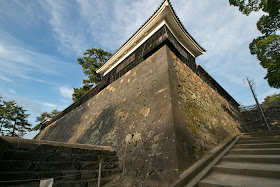


























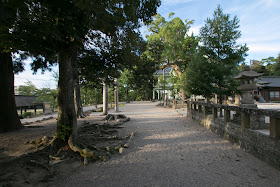



















































































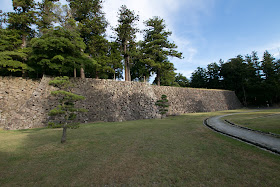















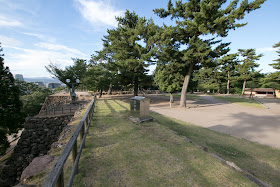
































































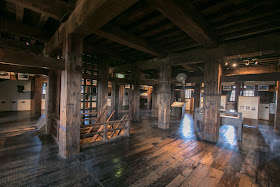






























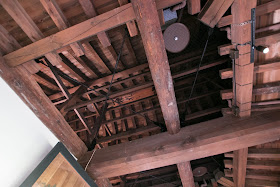



































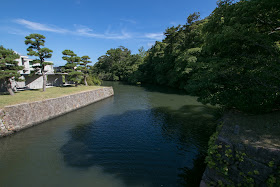





No comments:
Post a Comment